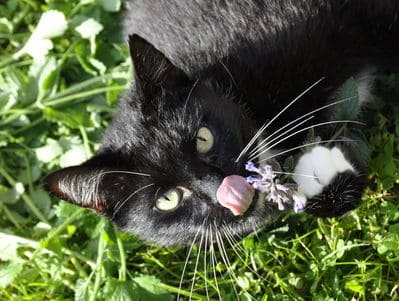

The range of behaviors that cats display in response to catnip varies from cat to cat and can also vary significantly between exposures. These behaviors include playful antics, rolling on their backs, rubbing their heads and cheeks up against the catnip or object containing the catnip, going into a trance, purring profusely, drooling, licking, growling, fighting, and generally becoming a hyperactive supercharged kitty or a zoned out feline! The variation in these behaviors is intriguing and makes it even more fun to watch.
Does Catnip Excite or Mellow a Cat?
The answer to this question depends on whether or not the cat smells the catnip or eats the catnip, because the effect for each is very different. When cats smell catnip, it triggers them to become excited. They often become much more frisky and loving than normal. Some cats even become aggressive when they smell catnip. On the other hand, when a cat eats the leaves, flowers, or stems from a catnip plant, it makes them mellow out, i.e. it has the opposite effect. They become calmer and may experience a feeling of euphoria. This is the same effect that is seen in humans when they drink catnip tea, which was once a more popular drink and is still popular among herbalists. Ingesting catnip seems to have a calming effect on both cats and humans, similar to the effect of chamomile tea and peppermint tea.
How Does Catnip Work on a Cat?
The active ingredient in catnip is called nepetalactone. It is found in the volatile oil of catnip, a member of the mint family. This chemical is similar to, and mimics, the effect of a pheromone found in male cat urine. The response it elicits is considered psychosexual in both males and females. This means it triggers the same types of emotional and physical behaviors that cats exhibit when they become sexually aroused. As a cat rubs against catnip, this bruises the leaves and stems. In doing so, the nepetalactone is released into the air as micro-particles. These are immediately received by a special receptor in the cat’s olfactory system. As the nepetalactone enters the cat’s nose, it passes through to the vomeronasal organ (Jacobson’s organ) that is used to detect pheromones. This organ has a direct connection to the hypothalamus of the cat’s brain. This in turn triggers the stereotypical psychosexual response we observe most cats having to catnip.
Why Don’t All Cats Respond to Catnip?
Because the active compound in catnip triggers psychosexual behaviors, it does not work on kittens that are not sexually mature. Generally, this means kittens less than 3-6 months old will not respond to catnip. Likewise, older cats may lose interest in catnip even if they responded to it as a younger cat, in much the same way as they may lose interest in sexual activities when not neutered or spayed. Beyond this, it is important to note that approximately 15-25 percent of all sexually mature cats do respond to catnip. This is because it is a genetic trait that is not inherited by all cats. It is thought that this may be related to the origin of specific breeds of domestic cats, where those that originated in areas where catnip is not endemic may not have the gene that triggers the response. For example, some cats of a purely southern Asia descent do not respond to catnip and catnip is not native to this region.
Do Big Cats Respond to Catnip Too?
Yes! Most species of cats respond in some way to catnip. This is not only true for African wild cats, from which our domesticated cats descended, but also leopards, lynxes, cougars, tigers and, to a lesser degree, lions. It is always fun to see the same behaviors in the big cats that we see in our domesticated felines. Here is a YouTube video from the Big Cat Rescue that shows how much big cats love catnip: https://www.youtube.com/watch?v=_OPA1bZwOWc
Final Thoughts
Since different cats respond differently to catnip, it is best to introduce catnip to them for the first time indoors. If your cat happens to be one that gets the “kitty crazies,” he or she could potentially have such erratic behavior – and it could become a dangerous situation if they are outside. For example, some cats have been known to run into the street without paying attention to traffic and/or initiate fights when other animals when affected by catnip. It is also best to start your cat off slow on catnip until you know how he or she will react. Remember, too, that fresh catnip is far more potent than dried catnip. Also, dried catnip will eventually lose its potency over time.




